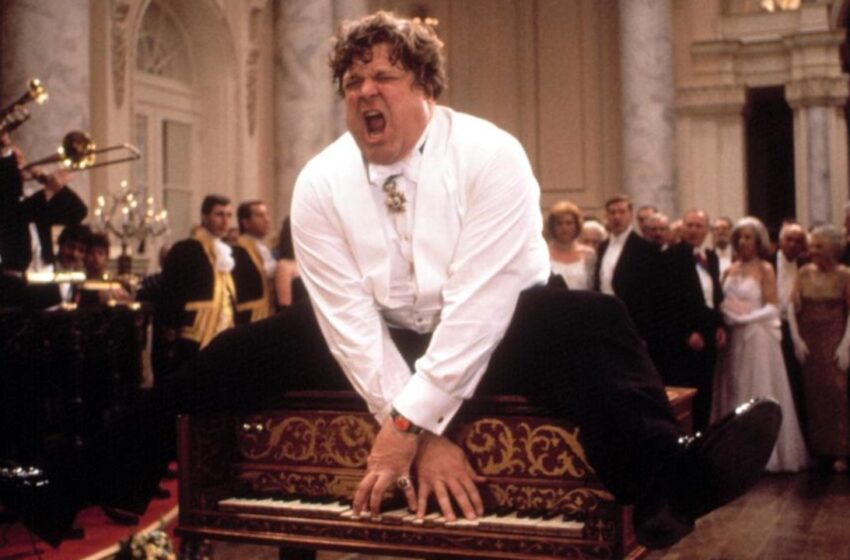
King Ralph (1991): From Vegas to Buckingham Palace – Review

With the inimitable John Goodman at the helm, this comedic romp from 1991 took audiences on a hilariously improbable royal adventure. And while the premise might sound like the result of a late-night brainstorming session after one too many pints at the pub, the film is a testament to Goodman’s rise as one of the ’90s most beloved and versatile actors.
In the shimmering universe of Hollywood, where physical appearance often dictates the trajectory of an actor’s career, John Goodman emerged as a beacon of exceptional talent that defies conventional norms. Over the years, Goodman’s physique, particularly his weight, has been a focal point, sometimes overshadowing the depth and versatility of his craft. But despite the industry’s obsession with looks, Goodman’s undeniable talent has carved out a niche for himself, proving that true artistry transcends superficial boundaries.
Hollywood, for all its glitz and glamour, often operates within a prescriptive mold, especially when it comes to casting. Leading men in the 90s were expected to fit a certain archetype: tall, chiseled, and conventionally handsome. While Goodman certainly has a commanding presence and a charisma that’s hard to ignore, his larger frame didn’t fit the stereotypical mold of a Hollywood leading man.
Plot: A Royal Fish Out of Water
When the entire British royal family finds itself, well, shockingly “discharged” due to an unfortunate photography incident, the hunt for the next in line leads to none other than Ralph Jones (John Goodman). Ralph is a Las Vegas lounge singer, more accustomed to sequined jackets than regal robes. As he clumsily navigates the intricacies of palace life, from protocols to public appearances, the result is a series of comedic gaffes, unexpected alliances, and ultimately, a journey of self-discovery.
John Goodman: The ’90s Renaissance Man
By the time “King Ralph” graced the silver screen, John Goodman was no stranger to Hollywood. With standout performances in films like “Raising Arizona” and “Sea of Love,” and of course, his iconic role as Dan Conner in the hit TV show “Roseanne,” Goodman was rapidly establishing himself as a force to be reckoned with.
“King Ralph” allowed Goodman to showcase his comedic chops, proving that he could carry a film with his impeccable timing, endearing charisma, and the ability to make audiences root for the underdog. Ralph’s bumbling attempts at royalty, whether it’s playing baseball in palace hallways or turning diplomatic dinners into rock concerts, are a testament to Goodman’s ability to infuse warmth and humor into any character.
John Goodman’s journey in Hollywood serves as an inspiration for many aspiring actors who may not fit the “traditional” mold. His success underscores the importance of skill, dedication, and passion in an industry that can often be superficial. While looks might open doors in Hollywood, it’s talent and hard work that ensures longevity and respect.
Behind the Scenes: Crafting a Comedic Kingdom
“King Ralph” was directed by David S. Ward, known for his work on “Major League.” The film brought together a cast that included Peter O’Toole and John Hurt, adding a layer of gravitas and wit to the narrative. The juxtaposition of Goodman’s brash, all-American demeanor against the backdrop of Britain’s reserved aristocracy provided ample opportunities for comedic gold.
The production faced the challenge of making the outlandish premise believable. Sets were meticulously designed to capture the grandeur of British royalty, from opulent palace interiors to grand ballrooms. Costume design played a pivotal role, with Ralph’s transformation from denim-clad musician to regally attired monarch providing visual humor.
Additionally, the film’s soundtrack, peppered with classic rock and roll hits, added an audial dimension to Ralph’s cultural clash. Scenes of him introducing the royal staff to the joys of American music are both humorous and heartwarming, highlighting the film’s underlying theme of unity amidst differences.
A Cultural Reflection: When Two Worlds Collide
Beyond the laughs, “King Ralph” serves as a comedic mirror to the cultural disparities between the US and the UK. The film plays on stereotypes, from the stiff-upper-lip Brits to the boisterous American, using them to highlight the absurdity of preconceived notions. Through Ralph’s journey, the film subtly underscores the idea that leadership and worth aren’t determined by lineage but by character and integrity.
Final Thoughts: All Hail King Goodman!
“King Ralph” might not be an Oscar contender, but it’s a delightful romp that celebrates the unexpected. It’s a film that reminds audiences to embrace the unexpected and find common ground in the unlikeliest of places. But perhaps, most importantly, it’s a testament to John Goodman’s unparalleled talent. His rise in the ’90s was no accident. With roles that showcased his range, from the lovable patriarch to the accidental monarch, Goodman proved time and again that he was Hollywood royalty in his own right.
Goodman’s enduring appeal and the critical acclaim he has received over the years prove that audiences and critics alike recognize and appreciate genuine talent. His weight, rather than limiting him, added layers to his characters, making them more human and relatable.
In the grand tapestry of ’90s cinema, “King Ralph” shines as a quirky, comedic jewel. It’s a film that invites viewers to laugh, to cringe, and to root for the underdog. And in an era defined by its unique blend of humor and heart, “King Ralph” stands as a crowning achievement.




